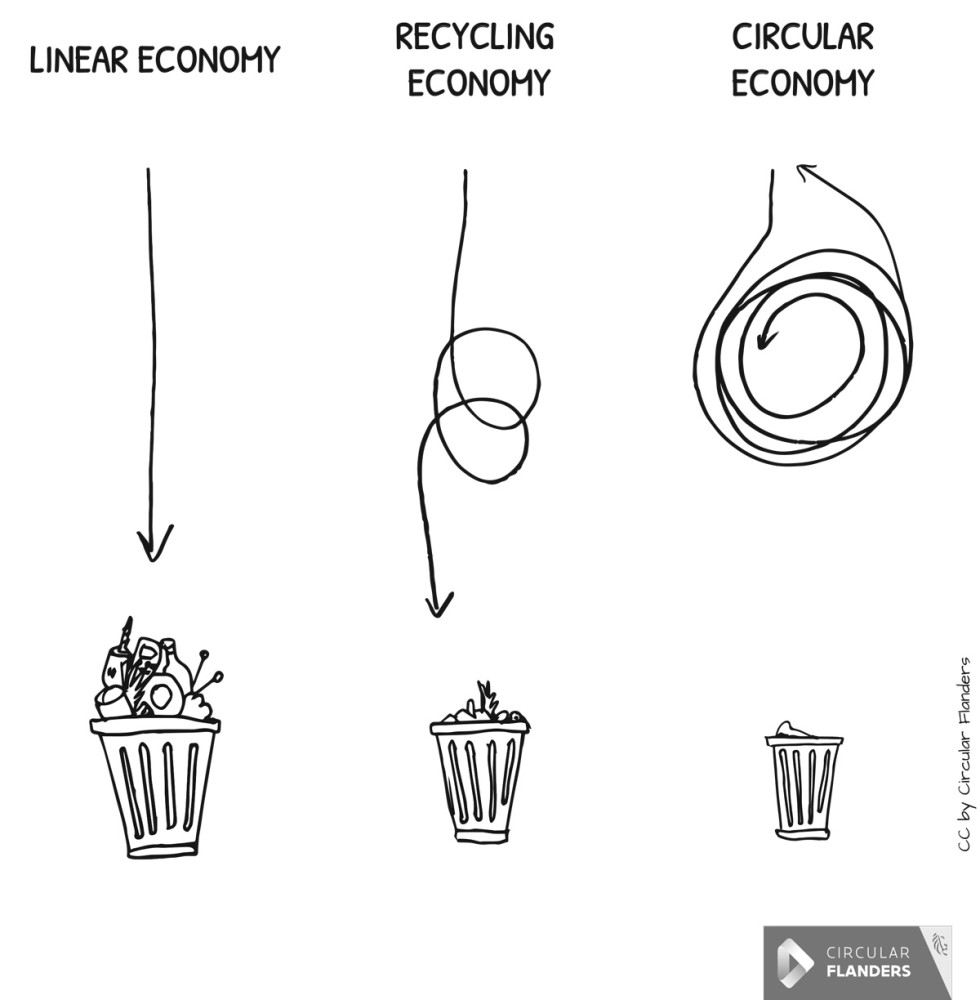In 1684 Thomas Savery invented the steam engine and it changed everything. This invention kick-started the industrial revolution, which transformed our ability to make things at scale. Raw materials and energy were seemingly infinite, and labour was readily available. For the first time in history, goods were mass-produced and at price points unthinkable before.
The Industrial Revolution laid the foundation for how the economy of today operates. In our current traditional linear economy, we take materials from the Earth, make products from them, and eventually throw them away as waste. This model is not sustainable in the long run, as it relies on the constant extraction and consumption of finite natural resources.
In a circular economy, by contrast, we stop waste from being produced in the first place by aiming to keep resources in use for as long as possible. Reducing the need for constant resource extraction by optimizing the use of natural resources resulting in diminishing waste production. The concept of a circular economy is a comprehensive one. It encompasses all parts of our lives, from the cradle to the grave. Circularity and the circular economy are emerging principles that recognize the environment, economy, and society as an interdependent whole. The advantages of circularity stem from the fact that it offers greater potential for innovation, increased efficiency in use of resources and energy, and minimization of negative effects on the environment.
A circular economy is an alternative to a linear economy which is based on a take-make-dispose model. The proponents of this economic model believe that it is a viable option to achieve high levels of sustainability without diminishing the profitability of the business or reducing the number of available products and services.
In other words, a circular economy does not intend to simply combat the defects of a linear economy but provides a systematic shift that changes the economic system completely.
The three major principles of a circular economy are as follows:
- Ensure the materials, as well as the products, are still in use;
- Regenerate natural systems;
- Mitigate waste and pollution caused by an otherwise linear economy.
How does it work?
Businesses, organizations, and industries need to embrace the opportunities and benefits of a circular economy so that waste is ‘designed out’ of how we live - those who can do so first will have a competitive advantage. A circular economy is achieved by designing products smartly with their whole life cycle in mind, re-using and repairing/refurbishing to extend their useful life, and then when their life is deemed over, remanufacturing by combining reusable, repaired and new parts to the original specifications of the manufactured product.
There are several routes to embracing a circular economy including;
- Design: Products are made using regenerative materials and modular design techniques in order to be longer-lasting, easier to disassemble and repair, recycle non-functional parts after use to the original materials and minimize packaging waste. In essence - design out waste.
- Reuse: Waste is eliminated by designing product delivery in reusable containers or the product life cycle is extended by reusing for a less demanding or different application than the original.
- Repair: The linear economy has encouraged the constant race to build products that are cheaper, faster, lighter or better, giving rise to monolith, non-modular designs where one part failing makes the product unusable. It also makes the dismantling of the product for recycling of materials cumbersome or sometimes impossible. The ability to repair has to be built into the design so that its use, at least theoretically can be infinite. Many US states and European nations have started passing "right to repair" laws to combat this.
- Recycling: Products can be easily separated into component parts and homogenous materials, enabling them to be recycled to the original resource e.g. aluminum cans to ingots.
- Manufacturing: Use manufacturing processes that use raw material and energy more efficiently, minimize post-production waste and recycle that waste in-house.
- Refurbishing: Refurbishment is the restoration of the functionality or performance of the used product to its original and create a secondary market for the same.
- Re-manufacturing: Remanufacturing is a production-batch process in which used products or cores are disassembled, cleaned, repaired or refurbished, reassembled and quality tested to be new or like-new equipment.
- Business Model Innovation: Product as Service: Don't sell the product where ownership passes from manufacturer to buyer, but the buyer pays for the service or functionality he derives from it and is charged as per usage - number of uses or hours used or a subscription model. For example, a bulb manufacturing company charges for the number of hours you use it and if it fails replaces with a new one. Incentivizes the manufacturer to build more long-lasting bulbs!

Why do we need it?
In the natural world, most systems function in a circular model. A plant grows using energy from the sun, water, and nutrients from the soil, this plant is consumed by an animal, which in turn is consumed by another animal, and eventually, the animal at the top of the food chain dies and all the nutrients are returned to the soil to be used by a new plant. This circular system has worked for millions of years.
However, in more recent times, humans have developed a more linear approach to life. Taking resources, making things with them, and then disposing of them in various ways. Examples could include multi-layered plastic packets (e.g. chips packets) or cling wrap films that end up in a landfill site, or unwanted electronics that we throw away when a new shiny model is released. This has allowed us to rapidly grow global economies and living standards, but it comes at a cost to the environment and biodiversity.
The world’s population is expected to peak at 10 billion in 2050. Our resources, the earth’s raw materials, are not limitless. As a result, global labour and raw material costs are on the rise. To stop these impacts and mitigate the risk of running out of resources completely, we need to mirror natural processes more closely and move towards a circular model. This is where the term ‘circular economy' comes from.
Circular economy business opportunities can offer new ways to mitigate these risks to allow businesses to grow and diversify. In a circular economy, products and materials keep circulating in a high-value state of use, through supply chains, for as long as possible. For this reason, “making things last” is a moral, environmental and economic imperative. It is a resilient system that is good for businesses, people, and the environment.
The circular economy, when designed in a thoughtful and inclusive manner, has the potential to protect the environment, improve economics, and elevate social justice. Sustainability from its foundation requires social equity. How we extract, use, and dispose of our resources can affect already vulnerable communities disproportionately.
India
India has been on a hectic pace of economic growth and only partially collects, processes and recycles its waste, and it is worrisome since it is now the most populous country in the world. It is therefore very important that we embrace transitioning to a sustainable and circular economy for India to achieve its development goals without compromising on resource security. The various missions launched by the Government such as Make In India, Zero Defect India, and programmes like Smart Cities and Swachh Bharat Abhiyan (Clean India) resonate with the principles of a circular economy.
These opportunities are, in fact, providing scope for improvements through which innovation, as well as employment opportunities, can be generated. India needs to work on enabling its citizens to be responsible for example by segregating at source and also teach them the basics of it from the school level. The government should encourage investment in this sector by making it financially feasible for startups by providing them with incentives and also financing projects, if possible.
It should also make separate plans for every industry based on the environmental damage that it causes so that there is a roadmap provided in order to achieve the set goals. The roadmap must be made available to everyone, and there should be coordination among policymakers, citizens, industries as well as governing bodies at all levels.
India has huge potential in switching to a circular economy. It needs a master plan as well as innovative technology. The government should take the support of research institutions as well as industry experts so as to fill these gaps and smoothly transition into a circular economy while ensuring there is no compromise in economic growth.
Circular economy and waste
Waste is contextual. For a consumer, the eCommerce delivery packaging is waste but to a waste collector it is a resource that has value and earns her livelihood. To the recycler, it is raw material. So responsible waste management is today the first mile of enabling the circular economy and is what can provide momentum towards establishing it. But the needle will move substantially only when waste is designed out of products post consumption or at the end of their lifecycle. And today's waste management players (companies, entrepreneurs and workers) will become the reverse logistics conduits for refurbishing, re-manufacturing and recycling leading to longer life-cycles and full recovery of original resources.
 |
The holistic solution: Inclusive circularity
Envisioned by Hasiru Dala (the not-for-profit) and Hasiru Dala Innovations Private Limited (the for-purpose company), Inclusive Circularity is the enabling of a circular economy while integrating waste pickers, informal waste workers - such as sorters and baler - and informal micro waste entrepreneurs in the evolving supply chain. Currently, the circular economy momentum is best created through responsible waste management that will maximize resource recovery from waste generated through consumption.
The two rails of inclusive circularity are innovative circular economy business models on the one hand, and on the other, the capacity building and professionalizing of the informal waste sector to execute those business models. This is our idea of Inclusive circularity - leveraging the circular economy for a just transition to a waste-free world!























